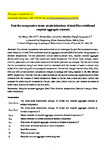Post-fire compressive stress–strain behaviour of steel fibre reinforced recycled aggregate concrete
| dc.contributor.author | Wang, T | |
| dc.contributor.author | Yu, M | |
| dc.contributor.author | Shan, W | |
| dc.contributor.author | Xu, L | |
| dc.contributor.author | Cheng, Shanshan | |
| dc.contributor.author | Li, L-Y | |
| dc.date.accessioned | 2023-02-13T14:11:34Z | |
| dc.date.available | 2023-02-13T14:11:34Z | |
| dc.date.issued | 2023-04-01 | |
| dc.identifier.issn | 1879-1085 | |
| dc.identifier.issn | 1879-1085 | |
| dc.identifier.other | 116735 | |
| dc.identifier.uri | http://hdl.handle.net/10026.1/20298 | |
| dc.description.abstract |
The uniaxial compressive tests were carried out to investigate the post-fire compressive stress–strain behaviour of steel fibre reinforced recycled aggregate concrete (SFR-RAC) after being exposed to elevated temperatures. The test parameters include water-to-cement ratio, recycled concrete aggregate (RCA) substituting ratio, steel fibre content and heated temperature. The failure mode, strength, elastic modulus, peak strain, and strain–stress response of the tested specimens are analysed. The test results show that the compressive strength and elastic modulus decreased with the increase of water-to-cement ratio and/or RCA substituting ratio at any exposed temperature. The residual strength retained about 83%, 85%, 56% and 23% of their ambient compressive strength on average after being exposed to 200, 400, 600 and 800 °C, respectively. The steel fibre has a positive effect on the residual mechanical properties and its effect increases with the increase of heated temperature. Based on the test data, a simplified explicit formula was proposed for predicting the compressive strength, peak strain, elastic modulus, and uniaxial compressive stress–strain constitutive model of the SFR-RAC. | |
| dc.format.extent | 116735-116735 | |
| dc.language | en | |
| dc.language.iso | en | |
| dc.publisher | Elsevier | |
| dc.subject | Recycled concrete aggregate | |
| dc.subject | Steel fibre | |
| dc.subject | Elevated temperatures | |
| dc.subject | Residual strength | |
| dc.subject | Stress -strain relationship | |
| dc.title | Post-fire compressive stress–strain behaviour of steel fibre reinforced recycled aggregate concrete | |
| dc.type | journal-article | |
| dc.type | Journal Article | |
| plymouth.author-url | https://www.webofscience.com/api/gateway?GWVersion=2&SrcApp=PARTNER_APP&SrcAuth=LinksAMR&KeyUT=WOS:000927369600001&DestLinkType=FullRecord&DestApp=ALL_WOS&UsrCustomerID=11bb513d99f797142bcfeffcc58ea008 | |
| plymouth.volume | 309 | |
| plymouth.publication-status | Published | |
| plymouth.journal | Composite Structures | |
| dc.identifier.doi | 10.1016/j.compstruct.2023.116735 | |
| plymouth.organisational-group | /Plymouth | |
| plymouth.organisational-group | /Plymouth/Faculty of Science and Engineering | |
| plymouth.organisational-group | /Plymouth/Faculty of Science and Engineering/School of Engineering, Computing and Mathematics | |
| plymouth.organisational-group | /Plymouth/REF 2021 Researchers by UoA | |
| plymouth.organisational-group | /Plymouth/REF 2021 Researchers by UoA/UoA12 Engineering | |
| plymouth.organisational-group | /Plymouth/Users by role | |
| plymouth.organisational-group | /Plymouth/Users by role/Academics | |
| dcterms.dateAccepted | 2023-01-19 | |
| dc.rights.embargodate | 2024-1-30 | |
| dc.identifier.eissn | 1879-1085 | |
| dc.rights.embargoperiod | Not known | |
| dc.rights.embargoperiod | 2024-01-30 | |
| rioxxterms.versionofrecord | 10.1016/j.compstruct.2023.116735 | |
| rioxxterms.licenseref.uri | http://www.rioxx.net/licenses/all-rights-reserved | |
| rioxxterms.type | Journal Article/Review |


